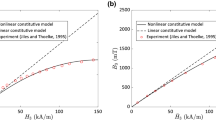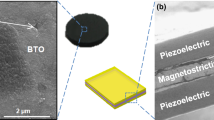Abstract
Experimental and theoretical results are presented for a composite magnetostrictive material system. This material system contains Terfenol-D particles blended with a binder resin and cured in the presence of a magnetic field to form a 1-3 composite. Test data indicates that the magnetostrictive material can be preloaded in-situ with the binder matrix resulting in orientation of domains that facilitate strain responses comparable to monolithic Terfenol-D. Two constitutive equations for the monolithic material are described and a concentric cylinders model is used to predict the response of the composite structure. Experimental data obtained from the composite systems coincide with the analytical models within 10%. Particle size, resin system, and volume fraction are shown to significantly influence the response of the fabricated composite system.
Similar content being viewed by others
References
Legvold, S., Alstad, J., & Rhyne, J., “Giant Magnetostriction in Dysprosium and Holmium Single Crystals”, Phys. Rev. Lett., V. 10, pp. 509, 1963.
Clark, A.E., Bozorth., R., and DeSava, “Anomalous Thermal Expansion and Magnetostriction of Single Crystals of Dysprosium”, B., Phys. lett, V. 5, pp. 100, 1963.
Clark, A.E., and Belson, “Giant Room-Temperature Magnetostrictions in TbFe2 and DyFe2”, Phys. Rev., V. B5, pp. 3642, 1972.
Millot, T.A. and P.P. Friedmann. 1994. ‘Magnetostrictively Actuated Control Flaps for Vibration Reduction in Helicopter Rotors’, Proceedings of the Second International Conference on Intelligent Materials, June 1994, Colonial Williamsburg, VA., pp. 900–913.
IEEE Standard on Magnetostrictive Materials: Piezomagnetic Nomenclature, no. 319, 1971.
Clark, A.E. 1992. ‘High Power Rare Earth Magnetostrictive Materials,’ Recent Advances in Adaptive and Sensory Materials and their Applications, Blacksburg, VA., pp. 387–398.
Brown, William Fuller, Magnetoelastic interactions. Springer-Verlang, 1966.
Carman, G.P. and M. Mitrovic. ‘Nonlinear Constitutive Relations for Magnetostrictive Materials with Applications to 1-D Problems’, Journal of Intelligent Material Systems and Structures, V. 6. no. 5, Sept. 1995, pp. 673–684.
Kannan, K.S. and Dasgupta, A, “Continuum Magnetoelastic Properties of Terfenol-D; What is available and what is needed”, Adaptive Materials Symposium, Summer meeting of ASME-AMD-MD, UCLA 1995.
Cao, W. Zhang, Q.M. and Cross, L.E. 1992. “Theoretical Study on the Static Performance of Piezoelectric Ceramic-Polymer Composites with 1-3 Connectivity”, J. Appl. Phys., Vol. 72 no. 12, Dec. 1992, pp. 5814–5821.
Bowen, C.P. T.R. Shrout C.A. Randall, of the Intercollege Materials Research Laboratory at Pennsylvania State University, University Park, Pennsylvania, ‘Intelligent Processing of Composite Materials’, Ad-Vol. 35, Adaptive Structures and Material Systems, ASME 1993.
Bi, J and Anjanappa, M 1994. “Investigation of Active Vibration Damping Using Magnetostrictive Mini Actuator”, Smart Structures and Intelligent Syst., Orlando FL, V. 2190, pp. 171–180.
Roberts, M Mitrovic, M and Carman, G.P., “Nonlinear Behavior of Coupled Magnetostrictive Material Systems Analytical/Experimental”, Smart Materials, San Diego 1995, pp. 341–355, 1995.
Sandlund, L Fahlander, M Cedell, T. Clark, A.E. Restorff, A.E. and Wun-Fogle, M “Magnetostriction, elastic moduli, and coupling factors of composite Terfenol-D”, J. Appl. Phys., May 1994.
Horn, C.L. and Shanker, N. “A Fully Coupled Constitutive Model for Electrostrictive Ceramic Materials”, Second International Conference on Intelligent Materials, ICIM’94, pp. 623–634.
Hashin, Z. and Rosen, R.W. 1964 ‘The Elastic Moduli of Fiber-Reinforced Materials’, J. of Appl. Mech., V. 31, pp. 223–234.
Carman, G.P. K.S. Cheung and D. Wang. ‘Micro-Mechanical Model of a Composite Containing a Conservative Nonlinear Electro-Magneto-Thermo-Mechanical Material’, Journal of Intelligent Material Systems and Structures, V. 6, no. 5, Sept. 1995, pp. 691–700.
Moffett, M.B. A.E. Clark, M. Wun-Fogle, J. Linberg, J.P. Teter, E.A. McLaughlin. 1991. ‘Characterization of Terfenol-D for Magnetostrictive Transducers,’ J. Acoust. Soc. Am. 89, pp. 1448–1455.
Acknowledgement
The authors of this paper gratefully acknowledge the partial support provided by the Army Research Office under contract DAAHO4-95-1-0095, contract monitor John Prater.
Author information
Authors and Affiliations
Corresponding author
Rights and permissions
About this article
Cite this article
Duenas, T.A., Hsu, L. & Cakman, G.P. Magnetostrictive Composite Material Systems Analytical/Experimental. MRS Online Proceedings Library 459, 527–543 (1996). https://doi.org/10.1557/PROC-459-527
Published:
Issue Date:
DOI: https://doi.org/10.1557/PROC-459-527




